|


| |
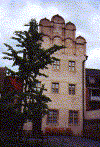 |
Wittenberg is the birthplace of the Lutheran
Reformation, where Martin Luther lived, wrestled with God through the
study of Scripture, taught, preached, wrote, got married, raised a family,
and held court with admiring students who wrote down every word he said
(1511-1546). |
Facts and Photos
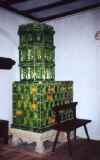 How
"the seedy little town of Wittenberg" (Kittelson, 127) in Electoral
Saxony became the center of the Reformation is one of those accidents of
history. Elector Frederick's newly-founded university (1502) "had not
flourished according to hope, and the elector endeavored to secure better
teachers by inviting the Augustinians and Franciscans to supply three new
professors. One of them was Luther. This was in 1511" (Bainton, 53). Philip
Melanchthon came in 1518 to teach the classics at the university, and in order
to keep him in this "seedy little town," Elector Frederick built and
gave as a gift to Melanchthon a house in 1536 (photo A, above). The porcelain
tile stove dates from 1600 (photo B). How
"the seedy little town of Wittenberg" (Kittelson, 127) in Electoral
Saxony became the center of the Reformation is one of those accidents of
history. Elector Frederick's newly-founded university (1502) "had not
flourished according to hope, and the elector endeavored to secure better
teachers by inviting the Augustinians and Franciscans to supply three new
professors. One of them was Luther. This was in 1511" (Bainton, 53). Philip
Melanchthon came in 1518 to teach the classics at the university, and in order
to keep him in this "seedy little town," Elector Frederick built and
gave as a gift to Melanchthon a house in 1536 (photo A, above). The porcelain
tile stove dates from 1600 (photo B).
While Melanchthon and his family lived in a home designed for their needs,
Luther continued to live–even after his marriage–in the Augustinian
monastery, along with wife, children, servants, students, and extended family.
With the Reformation and Luther's critique of monastic life, the monastery had
dissolved in 1522. In 1532 Elector John the Steadfast gave the cloister, along
with the yard and gardens, to Luther.
In 1540 Katherine Luther had special birthday gift commissioned for Luther, a
fancy doorway of carved sandstone from Pirna (photo C; Miriam and Richard Carter
are seated on the sitting niches). Know as the Katharine Portal, the gothic
style was typical of the times; there are similar portals in many German towns
and cities. Today most of the old monastery houses a museum of Reformation
history, but some rooms, including the family living room (photo D), have been
preserved as they were in Luther's day.
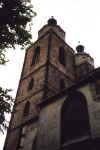 |
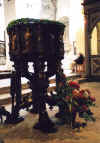 |
Construction began on St. Mary's church in 1411 (photo E). In this, the town
church, Luther preached and offered pastoral care; here he and Katherine von
Bora were married in 1525, their six children were baptized in the bronze font
that dates from 1457 (photo F), and the two who preceded them in death were buried.
The grave of Elizabeth, who only lived eight months, can still be seen today in
the chancel. Here also Carlstadt incited the laity to iconoclastic riots, which
led to the destruction of much of the art in the church, including many side
altars.
 The
altar triptych in the chancel (photo G), created by Lucas Cranach and his son,
painters from Wittenberg, depict the means of grace. On the left Philip
Melanchthon (a layman) baptizes an infant; on the right panel John Bugenhagen,
keys in hand, absolves a penitent sinner on the left while he refuses absolution
to the impenitent man on the right; in the upper center panel Jesus institutes
the Lord's Supper; in the lower center a preaching Luther points to the
crucified Christ. The
altar triptych in the chancel (photo G), created by Lucas Cranach and his son,
painters from Wittenberg, depict the means of grace. On the left Philip
Melanchthon (a layman) baptizes an infant; on the right panel John Bugenhagen,
keys in hand, absolves a penitent sinner on the left while he refuses absolution
to the impenitent man on the right; in the upper center panel Jesus institutes
the Lord's Supper; in the lower center a preaching Luther points to the
crucified Christ.
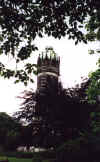 Many
Lutherans know that on October 31, 1517 Luther nailed his 95 Theses on the door
of the Castle Church. Hoffman provides the following details about the church,
which "was consecrated on January 17, 1503, and was initially reserved for
the nobility; from 1507 on it was also open to the university. Luther was
awarded the Doctor of the Holy Scripture in the Schlosskirche in October 1512. .
. . Here Carlstadt administered communion in both forms while wearing lay
clothing in 1521" (216). The church burned in 1760 during the Seven Years'
War, with only the outer walls and lower part of tower (photo H–rebuilt in the
nineteenth century) surviving the fire. Many
Lutherans know that on October 31, 1517 Luther nailed his 95 Theses on the door
of the Castle Church. Hoffman provides the following details about the church,
which "was consecrated on January 17, 1503, and was initially reserved for
the nobility; from 1507 on it was also open to the university. Luther was
awarded the Doctor of the Holy Scripture in the Schlosskirche in October 1512. .
. . Here Carlstadt administered communion in both forms while wearing lay
clothing in 1521" (216). The church burned in 1760 during the Seven Years'
War, with only the outer walls and lower part of tower (photo H–rebuilt in the
nineteenth century) surviving the fire.
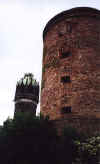 The
church is the "castle" church because it was part of the castle
complex built by Frederick the Wise from 1489 to 1525 (photo I), which once
housed Frederick's vast relic collection. The church was reconstructed in late
Gothic style and reconsecrated on Reformation Day 1892. Today the only relics of
saints in the church revered by pilgrims are the graves of Martin Luther (photo
J), located beneath the pulpit, and that of Philip Melanchthon, on the opposite
side of the chancel (photo K). The
church is the "castle" church because it was part of the castle
complex built by Frederick the Wise from 1489 to 1525 (photo I), which once
housed Frederick's vast relic collection. The church was reconstructed in late
Gothic style and reconsecrated on Reformation Day 1892. Today the only relics of
saints in the church revered by pilgrims are the graves of Martin Luther (photo
J), located beneath the pulpit, and that of Philip Melanchthon, on the opposite
side of the chancel (photo K).
Reflections
"That person deserves to be called a theologian, however, who
comprehends the visible and manifest things of God through suffering and the
cross." (Thesis 20, Heidelberg Disputation, 1518)
Seeing the grave of Martin and Katherine's daughter Elizabeth in St. Mary's
Church was a concrete reminder of the suffering Luther experience. His
biographers report that the death of their other daughter, Magdelene, at age 13,
was extremely painful for both parents. Garrison Keillor can make marvelous
jokes about the darkness in the Lutheran faith, and many people can complain
about traditional Lutheran hymnody because its too slow, not upbeat enough, and
too often in a minor key, but it is this aspect of the Lutheran tradition–the
theology of the cross–that I value most highly. Theologies that promise
happiness and success crumble under the capriciousness of real life. Gerhard
Forde, commenting on Thesis 20, writes: "Theologians of the cross are those
from whom all support other than the cross has simply been torn away. . . . By
faith we become a human being, a person of this world, a truly historical being,
because there is nothing to do now but wait, hope, pray, and trust in the
promise of him who nevertheless conquers, the crucified and risen Jesus. By
faith we are simply in Christ, waiting to see what will happen to and in
us" (80).
|
